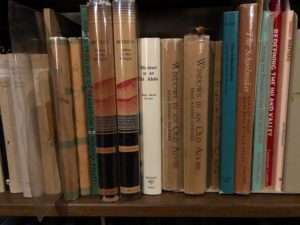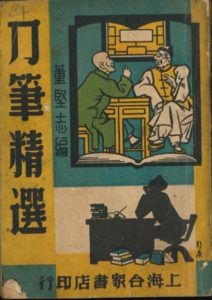Here are a few highlights of recent acquisitions for Special Collections. Contact us any time to request materials or a personalized tour.
Special Collections
Explore The Claremont Colleges Library’s most distinctive and unique resources—rare books, literary and historical manuscripts, maps, photographs, college archives, and more—for study and research.
Reading Room Hours
- Open by appointment
- Monday – Friday, 10 a.m. – 12 p.m., 1 – 5 p.m.
- To request an appointment outside of these hours, please contact us.
- Drop-in Fridays
- April 12, 19, 26, 2024 – 2 – 4 p.m.
- May 3, 2024 – 2 – 4 p.m.
Since there are so many different kinds of materials found in Special Collections – books, papers, photographs, maps, artifacts, to name a few – there are different ways to search for them. Each of the tabs above searches a different discovery system that Special Collections uses to organize and provide access to collections. Use them all to explore and find materials for your research. For guidance exploring, accessing, and using the collections, visit the Special Collections Access Guide or contact us.

Please Wear This Book
COVID-19 Artists Book by Tennille Shuster

Poster
Voces de la Frontera Print Collection

Books by Claremont authors
Claremont Authors Collection

Dao Bi Jing Xuan 刀筆精選
John Sheng Collection

First manuscripts arrive!
Fernando R. and Enriqueta Gomez Mormon Mexican History Collection

Quilting books
Written by Sandi Fox (PO'57); part of the Sandi Fox Quilting Archive

Consisting of over 21,000 photographs and over 11 linear feet of papers, books, magazines, business archives, and other property, the Archive represents the body of work of Hubert A. Lowman, photographer and publisher, and the Lowman Publishing Company.
Spanning almost 70 years (1939-2006), the Archive provides a unique insight into the business and subject matter of a commercial photographer. The bulk of the Archive focuses on the American West (primarily California and Arizona) and supports research into the historical depiction of their locations. Students of photography, environmental analysis, and history of the American West will find materials of research value in this collection. Students interested in the myriad of output of a commercial photographer (postcards, magazines and other publications, calendars, etc.) will not be disappointed. Those interested in learning about the use of imagery in teaching will enjoy discovering the educational study prints. Technique, composition, perspective, as well as other elements of photography (line, shape, form, texture, pattern, color, space, for example) could be traced throughout the collection.
Hubert A. Lowman was born on April 15, 1913, in Clay County Missouri, the son of Edward Lowman and Stacia Inez Potts. The oldest of three children, Hubert grew up with images and stories about the “wild west” from his father, and since childhood had wanted to see the west for himself. During the 1930s, Hubert spent his annual two-week vacation taking pictures in the west. In November 1939, he married Martha Guynn Howard and following the attack on Pearl Harbor, Hubert decided it was time to move to California where he found work in the Wilmington shipyards. When the war ended, he quit his job at the shipyard and announced he would become a freelance, scenic photographer.
Hubert had some early successes selling photographs to publications such as Arizona Highways and Desert magazines. Throughout the 1940s and 1950s, he developed a base of customers and began accepting contract, or customer-directed photo assignments, and continued to sell photographs as a freelance photographer to many other customers. Customers included Union Oil Company, Standard Oil Company, Smith News in San Francisco, magazines such as Arizona Highways, American Airlines, the California Mission Trails Association (CMTA), Disneyland, Knott’s Berry Farm, regional postcard distributors from California to Mississippi and concessionaires of national parks including Yosemite, Sequoia, Kings Canyon, Grand Canyon, Yellowstone, Glacier and Lassen Volcanic. In the late 1950s, Hubert teamed up with the curriculum department of the Los Angeles City Schools to create what were thought to be the first full-color study prints for use in school classrooms. By the end of the 1950s, Hubert had transitioned from being only a photographer to a businessman who published and sold his own photographic works.
All this time, Hubert operated his business under the name “Hubert A. Lowman, Photographer-Publisher.” Beginning in the 1970s, Martha worked alongside Hubert in the business as a partner until her death in August 1992. Soon after her death, he brought his older son, Edward (1943-2004) into the business and by early 1999, with Hubert’s permission, Edward coined and adopted the name “Lowman Publishing Company.” Following Edward’s death, Hubert’s younger son, Robert, and his wife, Kathleen, operated the business for Hubert until Hubert’s death in December 2006 at the age of 93. At that time, ownership passed to Robert, and Lowman Publishing Company continued to be a successful company.
In 2018, Robert Lowman gifted the Hubert A. Lowman Photographic Archive to Special Collections, The Claremont Colleges Library. The Archive is slated to be processed and a completed finding aid made available at the Online Archive of California in Spring 2022. In the meantime, the Archive is open for research and available to faculty at The Claremont Colleges for class visits to Special Collections and/or the incorporation of materials from the Archive into their teaching and research and the research of their students.
For more information or updates, please contact:
(909) 607-3977
specialcollections@claremont.edu
What’s happening in Special Collections? Follow along with the staff and students’ projects. Pictures & Conversations: Featuring new acquisitions and Special Collections news. Out of the Box: CCEPS students share updates on their projects as they explore specific collections.
The Deluge : Learn more about the Bending Water Project and the library’s mission to improve the accessibility of the data materials within the California Water Documents collection of the Claremont Colleges Digital Library.
Search our FAQs to find the answers you need.
Special Collections is the library’s principal repository for print and manuscript primary sources. The collections number nearly 200,000 volumes and more than 11,000 linear feet of a diverse array of literary and historical manuscripts, personal papers, and college archives that span more than 900 years of human history. The collections are available for research, teaching, and study in person, and, increasingly, digitally in the Claremont Colleges Digital Library. We provide an array of research support and instruction services to the students, faculty, and staff of The Claremont Colleges and the wider scholarly community; we partner with faculty and our library colleagues on course-integrated instruction, and we provide students opportunities to engage with and utilize primary sources in their research. Special Collections has a close relationship with the Ella Strong Denison Library at Scripps College, housed in the uniquely beautiful, historic Kaufmann Wing of the library building. Denison Library offers a wide variety of primary resources to The Claremont Colleges and wider community of scholars. Subject strengths include fine printing and artists’ books, women’s history, literature, and art. Denison holds the papers for the College’s founder, Ellen Browning Scripps, as well as the Scripps College archives.
The Claremont Colleges Library, 800 Dartmouth Avenue, Claremont, CA 91711
Phone: (909) 607-3977